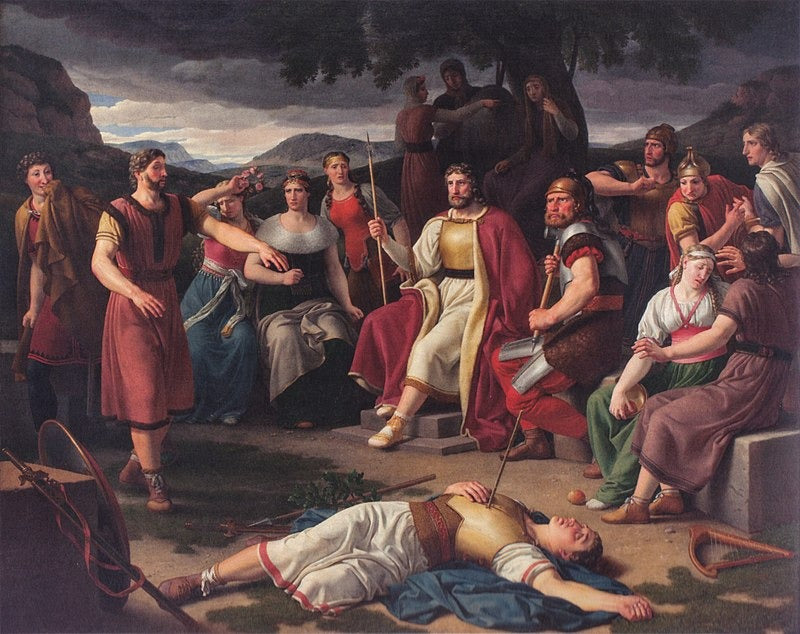
Freyr: Exploring the Norse God of Fertility, Prosperity, and Peaceful Abundance
Freyr represents a pivotal deity within the complex pantheon of Norse mythology, embodying profound cultural significance beyond simple theological representation. As a central figure among the Vanir gods, Freyr symbolized fundamental aspects of agricultural prosperity, peaceful existence, and generative power in Scandinavian prehistoric societies.
Mythological Origins and Genealogy

Gotland runestone 'G 181', depicting three men believed to be Odin, Thor, and Freyr. Located in the Swedish Museum of National Antiquities, Stockholm (Photo: Berig))
Belonging to the Vanir divine family, Freyr emerged as the son of Njörðr and brother to Freyja, two exceptionally significant mythological entities. His familial connections transcended typical divine relationships, representing intricate cosmological interactions characteristic of Norse theological frameworks.
Scholarly interpretations consistently emphasize Freyr's multifaceted role in Norse cultural imagination. Unlike more martial divine representations, Freyr personified generative processes, agricultural abundance, and peaceful social interactions.
Mythological Characteristics and Symbolism

Freyr possessed multiple powerful symbolic associations. Archaeological and textual evidence suggest he controlled crucial life-sustaining domains: fertility, prosperity, favourable weather conditions, and agricultural success. His divine portfolio extended beyond simple agricultural beneficence, encompassing broader societal well-being.
Multiple mythological sources describe Freyr's remarkable possessions, including a magical self-propelling ship Skíðblaðnir and a potent weapon capable of fighting independently. These supernatural artifacts underscored his profound supernatural capabilities while symbolizing technological and natural mastery.
Ritual Practices and Worship

Gold foil figure (known as a Gullgubber) may depict Gerðr and Freyr in a dance related to a fertility practice. Discovered in Hagebyhöga, Sweden and dates back to 700 AC (Photo: Björn Falkevik)
Archaeological investigations reveal extensive ritual practices surrounding Freyr. Particularly in Sweden, elaborate ceremonies celebrated agricultural cycles and communal prosperity. Temple complexes like Uppsala maintained sophisticated religious infrastructures dedicated to Freyr's veneration.
Seasonal agricultural festivals prominently featured Freyr, synchronizing religious observances with agricultural rhythms. These celebrations represented complex social mechanisms ensuring communal cohesion and agricultural productivity.
Historical Interpretations

Norse Viking Arm Ring with Raven Headed Terminus
Prominent scholars like Axel Olrik and Georges Dumézil have extensively analyzed Freyr's mythological significance. Their interpretations emphasize the deity's representation of fundamental Indo-European theological concepts of fertility and social regeneration.
Material culture findings, including carved figurines, runestones, and archaeological site investigations, consistently corroborate textual mythological narratives, providing multidimensional insights into Freyr's cultural importance.
Comparative Mythological Analysis

The Rällinge statuette from Södermanland, Sweden, assumed to be a depiction of Freyr from the Viking Age (Photo: Historiska Museet CC BY 2.5)
Freyr's mythological characteristics demonstrate remarkable similarities with fertility deities across Indo-European cultural frameworks. Comparative mythological studies reveal nuanced interconnections between different prehistoric theological systems.
Etymological analyses of Freyr's name and associated linguistic formations provide profound insights into prehistoric Scandinavian conceptual frameworks, extending beyond simple theological interpretations.
Transition and Cultural Transformation

Seafarer's Comb: Norse Drakkar Longship Hair Accessory
The gradual Christianization of Scandinavian societies fundamentally transformed indigenous religious practices. Freyr's theological significance progressively diminished, though cultural memories persisted through folkloric traditions and literary narratives.
Medieval literary sources, particularly the Prose Edda and Poetic Edda, preserved intricate mythological narratives, ensuring Freyr's cultural memory transcended immediate religious transformations.
Freyr emerges not merely as a divine entity but as a sophisticated cultural symbol embodying complex prehistoric Scandinavian understandings of social cohesion, agricultural prosperity, and cosmic interactions.
Frequently Asked Questions (FAQs)
- Where was Freyr primarily worshipped?
Primarily venerated in Sweden, with significant ritual centers in Uppsala and broader Scandinavian regions.
- What distinguished Freyr from other Norse deities?
Unique emphasis on peaceful prosperity and generative processes, contrasting with more martial divine representations.
- How did Christianization impact Freyr's worship?
Gradual theological displacement occurred, with indigenous practices progressively marginalized by emerging Christian frameworks.
- What archaeological evidence exists regarding Freyr?
Carved figurines, runestones, and temple site investigations provide substantial material culture insights.
- How do modern scholars interpret Freyr's mythological significance?
Contemporary interpretations emphasize complex cultural symbolism beyond simplistic theological categorizations.
References
Dumézil, Georges. Gods of the Ancient Northmen
Näsström, Britt-Mari. Freyja: The Great Goddess of the North
Simek, Rudolf. Dictionary of Northern Mythology
Lindow, John. Norse Mythology: A Guide to Gods, Heroes, Rituals, and Beliefs
Orchard, Andy. Dictionary of Norse Myth and Legend








